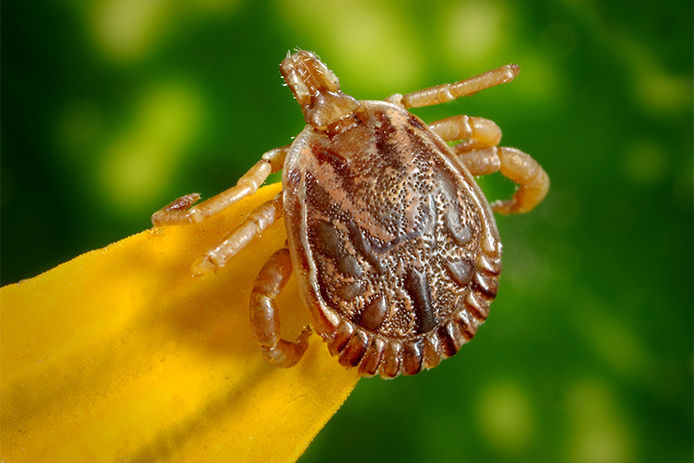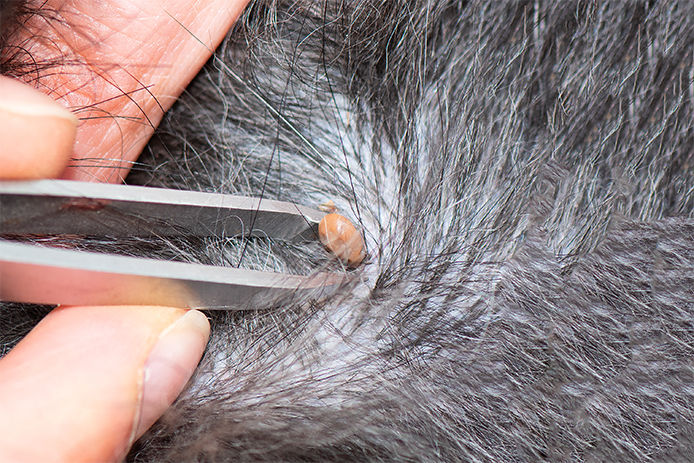How to Naturally Control Ticks

Just a mere mention of ticks can cause some people to feel unsettled. The idea of any insect latching on and sucking the blood of a human is pretty disconcerting. This is why people all over the country often turn to natural solutions for help in controlling and managing ticks. People's motivation to control ticks goes beyond just preventing a frightening idea, ticks pose some very real health threats to humans.
In North America, Lyme disease cases are growing at an astounding rate. The CDC claims 30,0000 Lyme disease cases reported annually. The absolute best way to prevent Lyme disease is to prevent tick bites. That said, ticks carry a robust selection of illnesses, like Rocky Mountain spotted fever and Ehrlichiosis.
Learning how to naturally control ticks empowers us to prevent illness. Here are a few, but essential ways to help naturally manage ticks.
Understand Where Ticks Thrive

Ticks love tall grass blades. Grass blades serve as a prominent method of tick to human transfer. Be aware of environments that ticks thrive in as an initial method of tick prevention. And no, it isn’t easy to prevent ticks in your lawn. There are a number of things you can consider to reduce ticks from using your lawn as a home, though. Theresa Smith, Director of Marketing at NaturaLawn of America, says “There are a number of plants that not only repel ticks but can keep fleas and sometimes mosquitoes away as well. For example, lavender plants, catnip, rosemary, and even chamomile. Tick prevention is best handled with proper education and defensive clothing.”
Tick-proof Clothing

When it comes to ticks, tick prevention starts by dressing properly. You need to cover your body, but similarly, not insulate yourself so much you overheat.
- First, consider wearing lighter colored clothing. This simply makes it easier for you to see a tick that just hopped aboard. The tick will not want to stay on your clothes, so your first line of defense is to rid yourself of them at first sight. A dark toned shirt may allow a tick to go visually undetected.
- Second, wear a hat. This can help prevent ticks from falling down and immediately finding your hairline.
- Third, long sleeves, long pants, socks, and tuck it all in. You need to cut off access to skin. Ticks will hop to clothing first, and then begin seeking out open flesh. If they can’t find the open flesh, you increase your chances that the tick never finds a home on your flesh.
Tick proof clothing decreases the success rate of tick bites.
Run Sticky Tape up Clothes

You’ve dressed to prevent ticks. But you can do more. A great way to prevent ticks, beyond just dressing in tick proof clothing, is to run some sticky tape up your clothing while outdoors. You can do it hourly, or as frequently as makes sense for your situation. This will snag ticks you might not visually see on your clothes. A little extra effort can go a long ways in tick prevention.
Make Your Own Natural Tick Prevention Oil

One intelligent way to approach tick prevention is to find all the things ticks despise and wear them. Try this natural tick prevention recipe next time you are outdoors.
Using a spray bottle, mix a cup of water with two cups of distilled white vinegar. Ticks hate white vinegar. Then blend in an essential oil of your own choosing. I’d recommend eucalyptus oil. Ticks don’t like eucalyptus and additionally, the essential oil can help diffuse that harsh vinegar smell so you get invited to the summer barbecue again.
How to Check for Ticks

Just because you’ve followed the natural tick prevention protocol doesn’t mean you’re off the hook. Ticks fiercely pursue their goal of finding a host (that’s you). Following all the above advice will definitely help you cut down on tick bite instances, but it won’t fully prevent them.
If you spend time outdoors, you’re susceptible to tick bites no matter how vigilant you are with tick prevention. You need to check for ticks each day, or at least on the days you’ve exposed yourself to the outdoors. Ticks can be as small as little sunflower seeds. This means ticks easily go unseen, even when attached. Ticks can find a home anywhere on your body. But they love the warm, not so obvious, spots. Don’t forget to check your armpits, the back of your neck, within your hair, and behind your knees and elbows. Showering after being outside can help knock ticks off of you, but don’t depend on that. Ticks remain attached to humans and animals under extreme duress.
How to Remove a Tick

You did everything you could to prevent a tick bite, but alas, you lost the battle. It happens to all of us. This is why it is essential to know how to remove a tick when you do indeed find one latched on. First and foremost, you shouldn’t panic. Panic can lead to poor tick removal. When you find a tick, it is best to use tweezers to grab the tick as close as you can at the surface of the tick’s attachment. Don’t smash the tick or twist the tick, this could mean leaving the head latched into your skin. You want to pull back with consistent, light force. Think “just enough force to get the job done.” Place the tick inside a jar filled with enough alcohol to submerge the tick. You can flush it down a toilet later. Determine how long you feel the tick was attached to you and consider calling your family’s medical professional for further instructions. Some doctors may want to run a Lyme disease test.
Ticks are the bane of existence for many hikers, campers, and outdoors lovers. But ticks also find their way into places where we commute daily, play with our pets and kids, and just stop to enjoy a moment of blue skies. By taking precautions in the way we dress to defend against ticks and how thoroughly we check ourselves for ticks, we can neutralize and limit the threats of several illnesses. We need not fear the outdoors, rather, we should prepare for it.